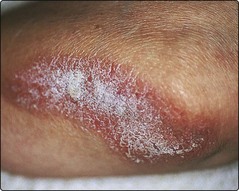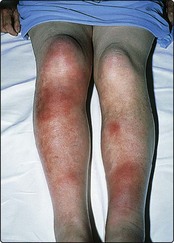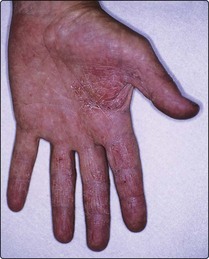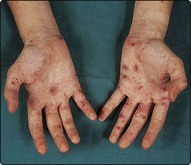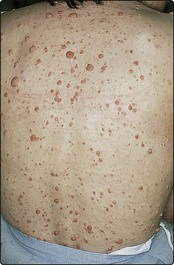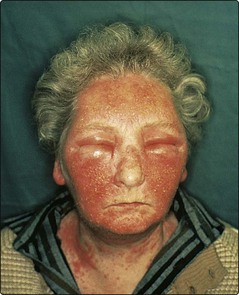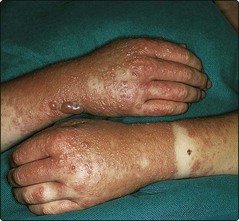Taking a history
The truism that ‘there is no substitute for a good history’ is just as applicable in dermatology as in any other branch of medicine. The time needed to take a history depends on the complaint. For example, the history in a patient with hand warts can usually be completed quickly, but more time and detailed questioning are required for the patient with generalized itching.
Presenting complaint
Case history 1
An 18-year-old male bank clerk developed a scaly erythematous plaque on the left elbow (Fig. 1) 6 months before presentation. It spread to involve the other elbow and both knees, but was not itchy. He developed scaliness in the scalp and nail dystrophy. His mother once had a similar rash.
Past medical history
Patients must be asked about any previous skin disease or atopic symptoms, such as hay fever, asthma or childhood eczema. Internal medical disorders may be relevant; these can involve the skin directly or may be associated with certain skin diseases. Prescribed or self-administered drugs may also cause an eruption. Dietary history is occasionally important, e.g. in some patients with atopic eczema (p. 36), but diet is often erroneously blamed for skin disease.
Case history 2
A 29-year-old woman was referred from the department of respiratory medicine where she had recently been diagnosed as having pulmonary sarcoidosis. Three weeks previously, she had developed tender, warm erythematous nodules (Fig. 2) on the shins. She was on no medication. An incisional biopsy confirmed the clinical impression.
Social and occupational history
Family history
Case history 4
An 18-year-old male student gave a 3-month history of an intensely itchy papular eruption affecting the hands, wrists and penis (Table 1). Several lesions were excoriated (Fig. 4). Treatment with a potent topical steroid was of little benefit. His girlfriend had also recently developed itchy lesions. Close examination showed burrows in the skin.
| Symptom | Intensely itchy eruption |
|---|---|
| Possible diagnosis |
Case history 5
A 25-year-old female shop assistant complained of brownish macules over her back (Fig. 5) and chest, which had first appeared in childhood and had gradually increased in number and size. During her teens, she had developed several soft pinkish, painless nodules on the trunk, some of which had become pedunculated. Her father had developed a few similar nodules in later life, and one of her two brothers had brown patches on his skin.
Diagnosis: von Recklinghausen’s neurofibromatosis (NF-1; p. 92).
Drug history
Case history 6
A 68-year-old woman had a minor irritating eruption on her forehead. She applied an antihistamine-containing cream that she bought in a pharmacy. Within 24 hours of applying it, her face became severely swollen (Fig. 6). Patch testing carried out later showed an allergic reaction to the cream.
Case history 7
An 18-year-old female secretary was given griseofulvin for a fungal infection. She went sunbathing and, 12 hours later, developed an eruption with a distribution in light-exposed areas (Fig. 7).
Taking a history
 Elicit the nature and temporal course of the eruption or lesion.
Elicit the nature and temporal course of the eruption or lesion.
 Enquire about atopic symptoms, general medical conditions and foreign travel.
Enquire about atopic symptoms, general medical conditions and foreign travel.
 Take a social, occupational and family history – it may be relevant. Ask about eczema or psoriasis in relatives.
Take a social, occupational and family history – it may be relevant. Ask about eczema or psoriasis in relatives.
 Identify any influence of the illness on day-to-day functions including work.
Identify any influence of the illness on day-to-day functions including work.
 Record the recent use of drugs and medications, including topical agents.
Record the recent use of drugs and medications, including topical agents.
 Ask about the use of cosmetics and, in relevant cases, exposure to sun or ultraviolet radiation (e.g. sunbeds).
Ask about the use of cosmetics and, in relevant cases, exposure to sun or ultraviolet radiation (e.g. sunbeds).

